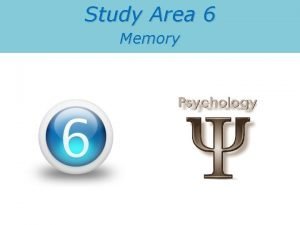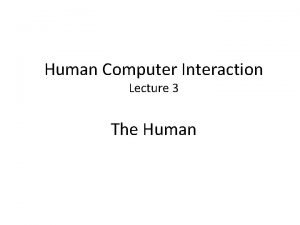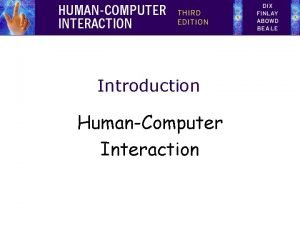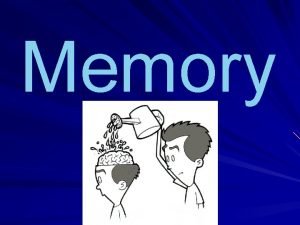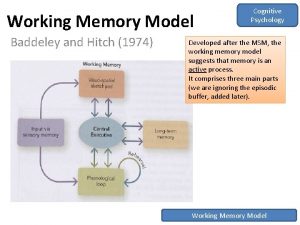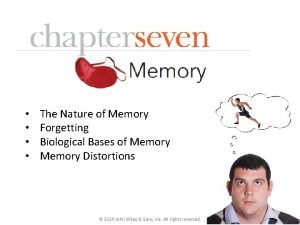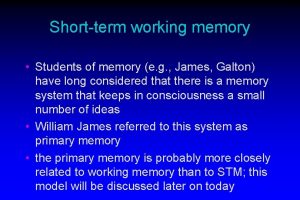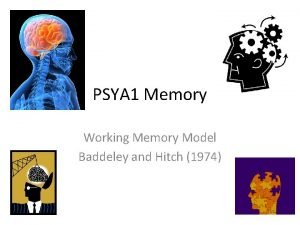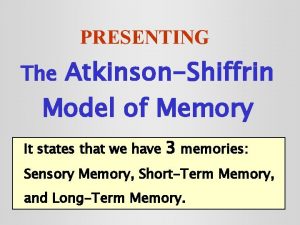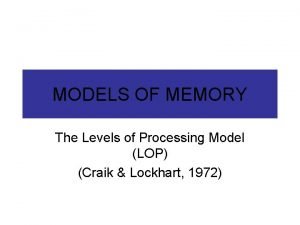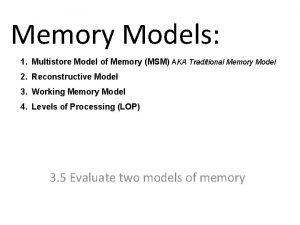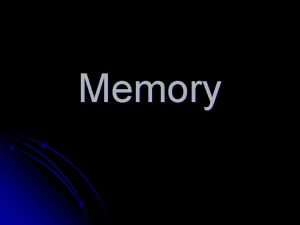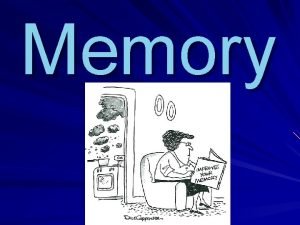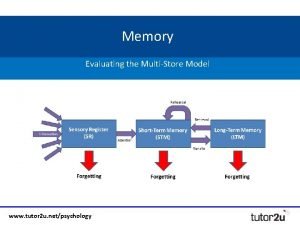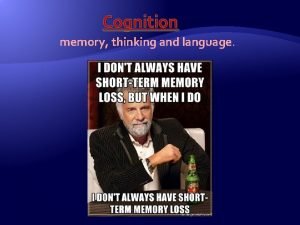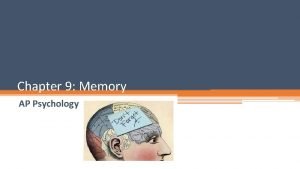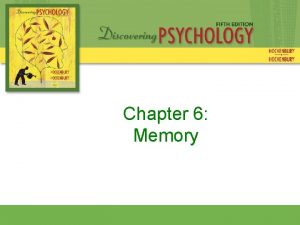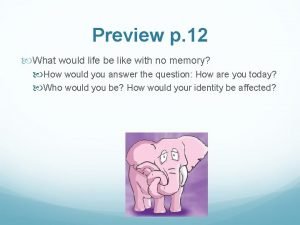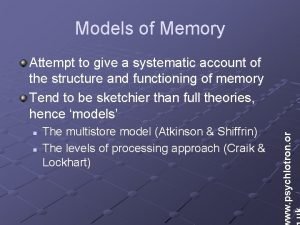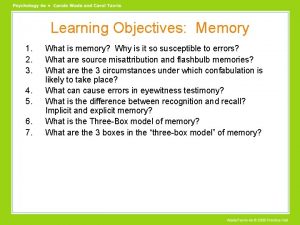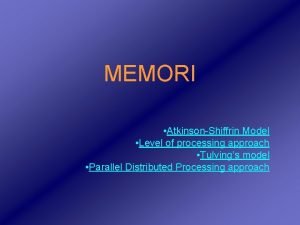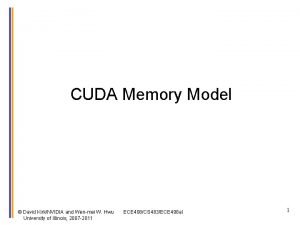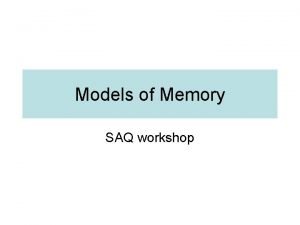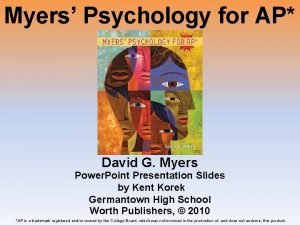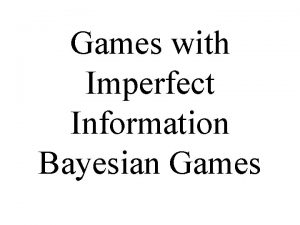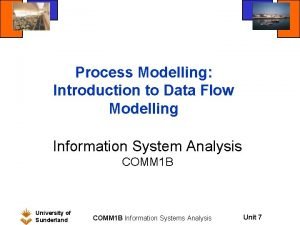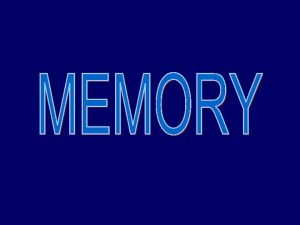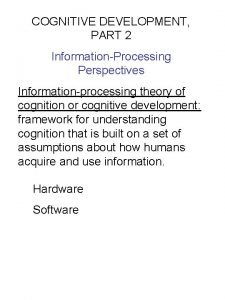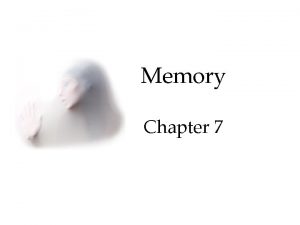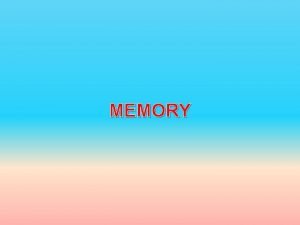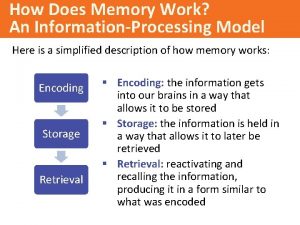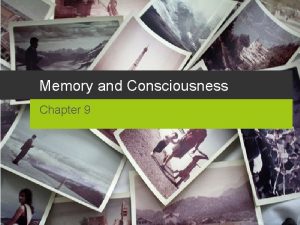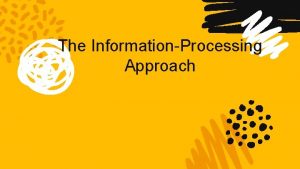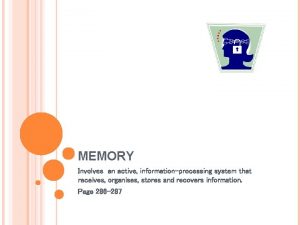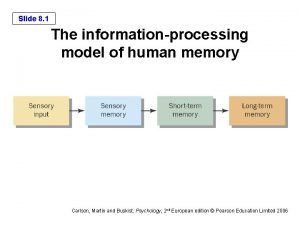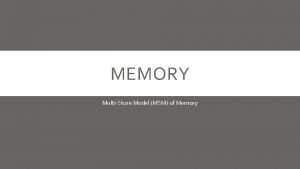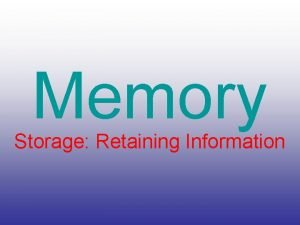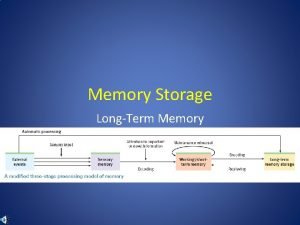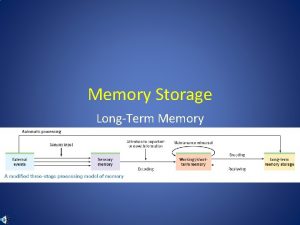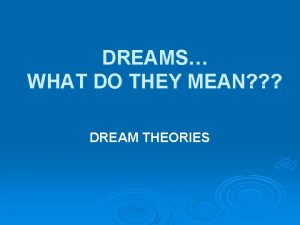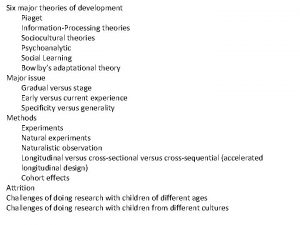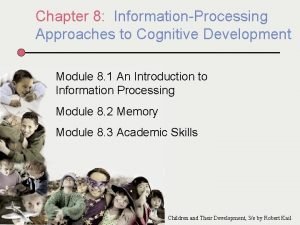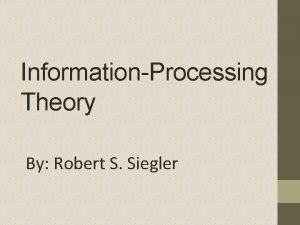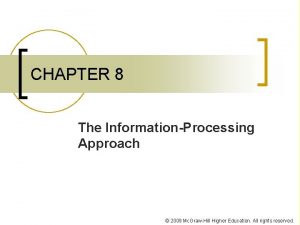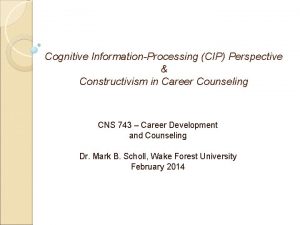Memory as an InformationProcessing Model Encodinggetting information in






































- Slides: 38


Memory as an Information-Processing Model Encoding-getting information in (Keyboard/Scanner) Storage: Retrieval. Monitor, Printer, Speaker Hard Drive=LTM RAM=STM/Working Memory

What do you forget? Names Where you put Telephone # you the _____ (keys). JUST checked! Not recalling you Forgetting what told somebody people told you. something What you started to do. What you were saying. Faces Remember if you _______ (turned off the stove). Specific words Directions

FLASHBULB MEMORIES


Characteristics of Flashbulb Memories: • A car accident you were in or witnessed? • An early romantic experience (first kiss? ) • A time you had to speak in front of an audience. • Surprising • When you got your admissions letter from college (coming soon? ) • Emotional • Your first flight. • Consequential • Not necessarily accurate but person believes they are. • Core event + other information • The moment you opened your SAT scores. • Your 16 th birthday. • First time your parents left you alone at home for some time. • OJ Simpson verdict.

ENCODING: Getting Information In!

How We Encode Automatic Processing • little/no effort • information about time, space, and frequency • without awareness or interference Effortful Processing • remember only with attention and conscious effort • often use rehearsal

Task: Write Down As Many Presidents As You Can Remember.

Effects on Encoding Process • Spacing Effect: tendency for distributed study/practice to yield better long-term retention. • Serial Position Effect: recalling the last/first items in the list (President Activity)

With IMMEDIATE recall, the last items are best remembered. SERIALPOSITION EFFECT With LATER recall, the first items in the list are better remembered.

Encoding • Forgetting as encoding failure • Which penny is the real thing?

If you repeated a word list 8 times on Day 1, it took 20 minutes to relearn list on Day 2. If you repeated a word list 32 times on Day 1, it took 14 minutes to relearn it on Day 2


Can you recall these letters? N-F L-C-B S-U-S A-V-C R-F-B I

Items at the top serve as cues for items underneath! P 9 reading Hierarchies

You have 10 seconds to remember the following string of numbers…. . GO! 19881989199019911992199319941995



Iconic Memory-a fleeting photographic memory

Duration of STM

STM Capacity -stm capacity demonstration: p 12/14 number series.

P 15 number series

LTM Duration: Fades then levels off. Non-sense syllables Spanish vocab LTM Capacity-unlimited!

IS EVERYTHING IN THERE? No, flashbacks are rare & probably invented like dreams!

THE HUMAN BRAIN

Less Prompting (fewer cues Needed) Stronger Connections =more NT efficiency More Connections Made LONG TERM POTENTIATION: Synaptic changes in the Brain! INHIBITING LTP ENHANCING LTP • Drugs that block LPT (ex: block serotonin • Drugs that enhance LTP (ex: increase serotonin) • Alcohol • Short-term stress (hormones+glucose= strong emotion) • Concussions • ECT (electro-convulsive therapy • Long-term stress

How You Do Something What You Know Left Brain Right Brain HIPPOCAMPUS-processes new info ready for transfer. Evidence-solve problems & read faster, better golf scores with no memory of event. CEREBELLUM


Evidence of Memory: • Faster relearning • Recognition Retrieval Cues: • Context Effects • Moods PRIMING“awakening associations. ” Handout 9 -5 ab Context Effects. Recall increases in context of the learning location! Where should you take the AP Exam? In Room G 25! Do you? No.

State-dependent Memories Mood-congruent Memories • Happiness • Joy • Drug-altered state (even drunk) Depressed Memories • Sadness Identical states lead to better recall (but drugs/depression impair memory overall) Depressed Moods MOODS SERVE AS CUES AND INFLUENCE CURRENT MOOD.

INTERFERENCE- retroactive & proactive interference. “It’s in there, but I can’t get it out of LTM. ” MOTIVATED FORGETTINGrepression & misinformation effect.

Being asked for old information…. new learning interferes.

Jan 2002 April 2002 June 2002 Test on World War I Retroactive Interference WW 2 learned 2 nd, interferes with WW 1 info. Test on World War II Proactive Interference WW 1 learned 1 st, interferes with WW 2 info.

Amount of information that is retained if sleep comes after studying

Forgetting occurs all along the memory process. Freud: We forget Information that is Anxiety producing. REPRESSION

“Memory isn’t like reading a book; it’s more like writing a book from fragmentary notes. ”

False Memories • Misinformation Effect-when false information is included in memories due to exposure to misleading information (Ex: leading questions in a court room). Imagination Effect works in a similar way. • Why? We tend to fill in gaps with guesses and assumptions. • Source Amnesia-attributing an event to the wrong source (mixing fact with fiction). • False memories feel real and are persistant. How can we identify false memories? Lack of sensory lobe activation is one way. • Abused Children & Accused Adults-forgetting happens, recovered memories happen but not typically under hypnosis or drugs or of events before the age of three. Real memories and false memories can be upsetting but real emotional, traumatic events are typically vivid, haunting, memories. Young children are also susceptible to the misinformation effect. Handout 9 -6 & Alan Alda Video “The things we remember best, are those better forgotten. ”
 Prototypes in semantics
Prototypes in semantics Explicit and implicit memory
Explicit and implicit memory Long term memory vs short term memory
Long term memory vs short term memory Internal memory and external memory
Internal memory and external memory Primary memory and secondary memory
Primary memory and secondary memory Logical address
Logical address Which memory is the actual working memory?
Which memory is the actual working memory? Page fault
Page fault Virtual memory in memory hierarchy consists of
Virtual memory in memory hierarchy consists of Eidetic memory vs iconic memory
Eidetic memory vs iconic memory Shared vs distributed memory
Shared vs distributed memory The declarative memory that contains personal information
The declarative memory that contains personal information Derive logically necessary conclusion from given premises
Derive logically necessary conclusion from given premises Information reproduced from memory can be assisted by cues.
Information reproduced from memory can be assisted by cues. What is the persistence of learning over time
What is the persistence of learning over time What is a working model psychology
What is a working model psychology Memory stages model
Memory stages model Slave systems working memory model
Slave systems working memory model Baddeley's theory of working memory
Baddeley's theory of working memory Atkinson shiffrin model of memory
Atkinson shiffrin model of memory Lop model of memory
Lop model of memory Multistore memory model
Multistore memory model Modal model of the mind
Modal model of the mind Organizing items into familiar manageable units
Organizing items into familiar manageable units Evaluate the multi store model of memory
Evaluate the multi store model of memory Memory stages model
Memory stages model Memory processing
Memory processing Encoding specificity
Encoding specificity Atkinson and shiffrin's three-stage model of memory
Atkinson and shiffrin's three-stage model of memory Multi store model
Multi store model Three box model of memory
Three box model of memory The level of processing approach
The level of processing approach Cuda memory model
Cuda memory model Saq 1
Saq 1 Modified three stage processing model of memory
Modified three stage processing model of memory Chicago multiple nuclei model
Chicago multiple nuclei model Incomplete vs imperfect information
Incomplete vs imperfect information Information flow model
Information flow model Explain about visa international security mode
Explain about visa international security mode











